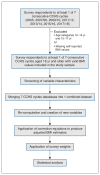Trends in obesity across Canada from 2005 to 2018: a consecutive cross-sectional population-based study
- PMID: 35609927
- PMCID: PMC9259440
- DOI: 10.9778/cmajo.20210205
Trends in obesity across Canada from 2005 to 2018: a consecutive cross-sectional population-based study
Abstract
Background: Obesity is increasingly prevalent worldwide and is becoming an epidemic in many countries, including Canada. We sought to describe and analyze temporal obesity trends in the Canadian adult population from 2005 through 2018 at the national and provincial or territorial levels.
Methods: We conducted a consecutive, cross-sectional study using data from 7 sequential Canadian Community Health Survey (CCHS) cycles (2005 to 2017/18). We included data from Canadian adults (age ≥ 18 yr) who participated in at least 1 of the 7 consecutive CCHS cycles and who had body mass index values (calculated by Statistics Canada based on respondents' self-reported weight and height). Obesity prevalence (adjusted body mass index ≥ 30) was a primary outcome variable. We analyzed temporal trends in obesity prevalence using Pearson χ2 tests with Bonferroni adjustment, and the Cochran-Armitage test of trend.
Results: We included data from 746 408 (403 582 female and 342 826 male) CCHS participants. Across Canada, the prevalence of obesity increased significantly between 2005 and 2017/18, from 22.2% to 27.2% (p < 0.001). We observed increases across both sexes, all age groups and all Canadian provinces and territories (p < 0.001). In 2017/18, the prevalence of obesity was higher among males than females (28.9% v. 25.4%; p < 0.001); the prevalence among adults aged 40-69 years exceeded 30%. In 2017/18, Newfoundland and Labrador had the highest prevalence (39.4%), and British Columbia had the lowest (22.8%) prevalence of obesity. Over the 14-year study period, Quebec and Alberta exhibited the largest relative increases in obesity.
Interpretation: In 2017/18, more than 1 in 4 adult Canadians lived with obesity, and from 2005 to 2017/18, the prevalence of obesity among adults in Canada increased substantially across sexes, age groups and all Canadian provinces and territories to 27.2%. Our findings call for urgent actions to identify, implement and evaluate solutions for obesity prevention and management in all Canadian provinces and territories.
© 2022 CMA Impact Inc. or its licensors.
Conflict of interest statement
Competing interests: None declared.
Figures





References
-
- Obesity and overweight [fact sheet] Geneva: World Health Organization; pp. 2561–65. updated 2020 Apr. 1.
-
- Obesity: preventing and managing the global epidemic. Geneva: World Health Organization; 2000. (WHO Technical Report Series 894). - PubMed
-
- Li L, Liu D-W, Yan H-Y, et al. Obesity is an independent risk factor for non-alcoholic fatty liver disease: evidence from a meta-analysis of 21 cohort studies. Obes Rev. 2016;17:510–9. - PubMed
Publication types
MeSH terms
LinkOut - more resources
Full Text Sources
Medical
Miscellaneous
